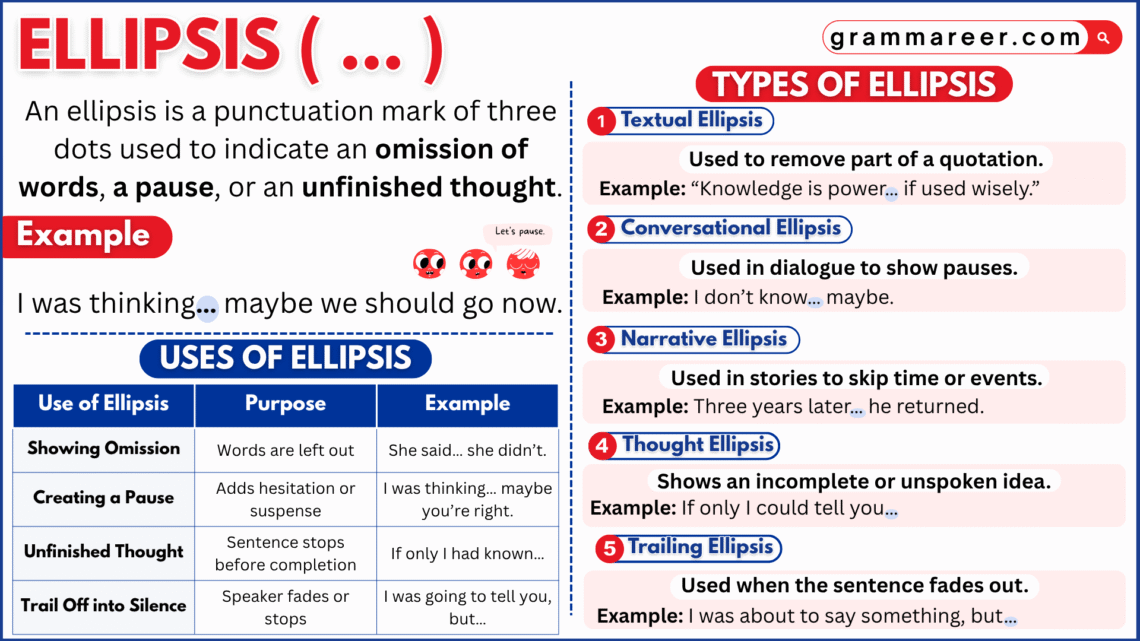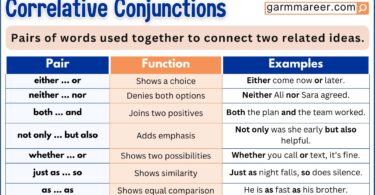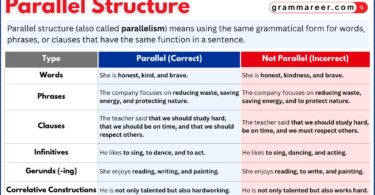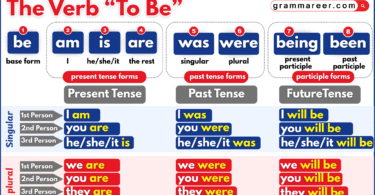An ellipsis is a set of three dots (. . .) that often appears when something is left unsaid, a pause is needed, or a few words have been omitted. You’ve probably seen it used in books, messages, or even social media posts to create suspense or show hesitation — that familiar dot, dot, dot moment.
Writers and speakers use ellipses to make their words sound more natural and expressive. They can show emotion, silence, or simply help shorten a long quote without changing its meaning. When used correctly, these tiny dots can make a big difference in how a sentence feels and flows.
In this article, we’ll explore what an ellipsis really means, how it’s used in writing, and see some easy examples to help you use it confidently.
Table of Contents
What Is an Ellipsis?
An ellipsis isn’t just a set of three dots — it’s a tool that adds meaning and emotion to writing. We use it when something is left out, when we want to pause for effect, or when there’s more to say but we choose not to.
In grammar, an ellipsis helps avoid repetition. Instead of repeating the same words, we simply leave them out because the reader can easily guess what’s missing. For example, instead of saying He likes coffee, and she likes tea, we can say He likes coffee, she tea. The missing word likes is understood from the first part.
In writing or storytelling, an ellipsis adds a dramatic touch. It can show hesitation, suspense, or something left unsaid like in this example:
- I was going to tell you something … but never mind.
Those three dots make the reader feel the pause, as if the thought is hanging in the air.
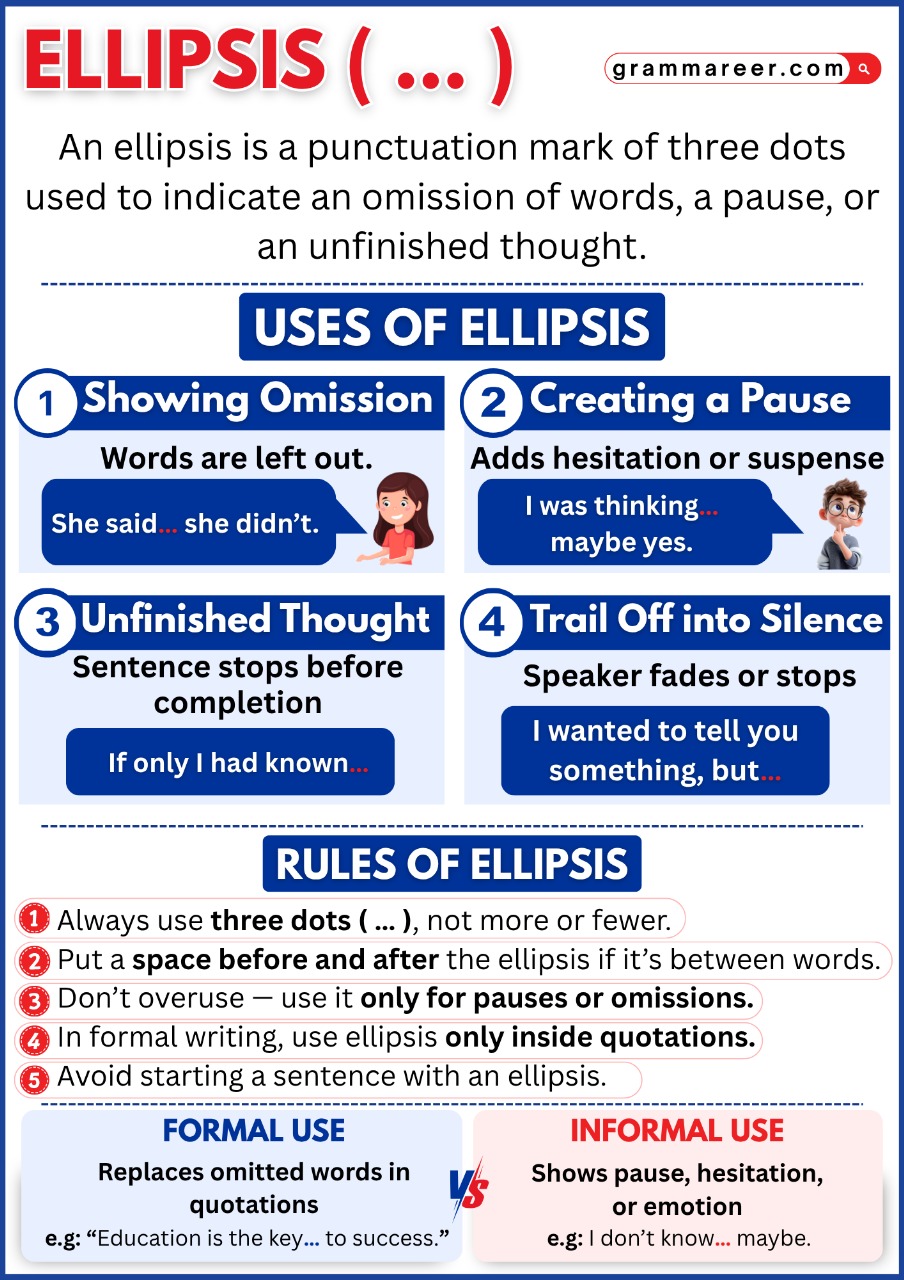
When to Use an Ellipsis
An ellipsis can do more than you might think. In writing, it’s not just a set of three dots — it’s a tiny pause, a shortcut, or even a hint of mystery. Here are a few common ways to use an ellipsis correctly and naturally.
1. To Show Omitted Words
Sometimes, you don’t need to include every single word from a quote. An ellipsis helps you skip the unnecessary parts without changing the meaning.
| Original quote: | With ellipsis: |
| • It must be obvious, from the very start, that there is a contradiction in wanting to be perfectly secure in a universe whose very nature is momentariness and fluidit | • It must be obvious […] that there is a contradiction in wanting to be perfectly secure in a universe whose very nature is momentariness and fluidity. |
When you use an ellipsis this way, make sure the sentence still makes sense after the cut. You can also place an ellipsis at the start of a quote if the beginning part has been left out.
Example:
- … and you wouldn’t believe the mess it made!
2. To Create a Pause or Build Suspense
An ellipsis can act like a dramatic pause — perfect when you want readers to stop and feel the tension before revealing something.
Example:
- I slowly turned the handle and opened the box to find … a tiny kitten staring back at me.
That pause makes readers wonder what’s coming next, which keeps them hooked.
3. To Show a Sentence Trailing Off
We often leave sentences unfinished when speaking — maybe because we lose our train of thought or want someone else to fill in the blanks. In writing, an ellipsis shows this natural hesitation or silence.
Example:
- I thought you were coming with us, but …
It feels like the speaker just stopped mid-sentence — exactly as people do in real conversations.
4. To Suggest There’s More to Come
An ellipsis at the end of a sentence can leave readers hanging, hinting that the story isn’t over yet. It’s great for cliffhangers or to spark curiosity.
Example:
- And just when I thought everything was finally calm …
This ending makes readers wonder what’s going to happen next — a perfect way to keep them engaged.
Ellipsis, Dash, and Colon — What’s the Difference?
Ellipses, dashes, and colons might look similar when used in writing, but they each have their own purpose. Understanding how they work helps your sentences flow naturally and makes your meaning clearer.
| Punctuation Mark | Main Use | Tone or Effect | Example Sentence | When to use |
|---|---|---|---|---|
| Ellipsis ( … ) | Shows a pause, unfinished thought, or missing words | Soft and open-ended | • I was going to tell you something … but I forgot. | Use it to show hesitation or omitted words. |
| Dash (—) | Adds extra information or shows a sudden break | Strong and dramatic | • I was just about to call you — and then my phone died! | Use it when you want a sharp, noticeable pause. |
| Colon (:) | Introduces a list, quote, or explanation | Clear and direct | • She brought everything we needed: snacks, water, and a blanket. | Use it when you’re about to give more details. |
Ellipsis vs. Ellipses
It’s easy to get mixed up between ellipsis and ellipses, but the difference is actually very simple. The word ellipsis refers to just one set of three dots — that familiar “dot, dot, dot” we use in writing. On the other hand, ellipses is the plural form, meaning more than one group of three dots.
For Example:
- One ellipsis looks like this → …
- Two or more ellipses look like this → … …
It can be confusing because even a single ellipsis already has three dots in it, but remember — it still counts as one punctuation mark. When you’re talking about several of them appearing in different places, that’s when you use the plural form ellipses.
In short, one set of three dots is an ellipsis, and two or more sets are ellipses. Simple, right?
Why Ellipsis Matters?
Ellipsis isn’t just about those three little dots — it’s a smart writing tool that can make your sentences shorter, smoother, or even more emotional. Whether you’re writing an essay, a story, or just texting a friend, knowing when and how to use an ellipsis can make a big difference.
1. It helps you keep things short and neat:
Sometimes, you don’t need to include every single word when quoting someone. Using an ellipsis lets you skip the unnecessary parts without changing the meaning.
Example:
| Original | With ellipsis |
| • “She said she would be there at 5, but she got late because of traffic.” | • “She said she’d be there at 5… but she got late.” |
See? It still makes sense — just cleaner and shorter.
2. It adds emotion and suspense:
Ellipses are also great in creative writing or storytelling. They can show hesitation, surprise, or something left unsaid.
Example:
- I was going to tell you something… but maybe later.
It feels a bit dramatic, doesn’t it? That’s the magic of an ellipsis.
3. But be careful — too many dots can be confusing!
Using ellipses too often can make your reader wonder what’s going on. If your thought isn’t clear, those dots might just leave people guessing.
Example:
- “Let’s meet tomorrow…”
Does that mean “Let’s meet tomorrow, but I’m unsure”? Or “I’m expecting you to say something”? The meaning isn’t clear.
4. Don’t change someone’s meaning
If you’re cutting words from a quote, make sure you’re not twisting what the person actually said.
Example:
| Original | Changed |
| • No one can truly grow unless they face challenges. | • No one can truly grow… |
Ellipsis Examples:
- I was thinking we could go out for dinner… maybe tomorrow?
- I don’t know… it just feels different today.
- Well… that’s not what I expected.
- And then… everything went silent.
- He looked at her and whispered… “I know.”
- I thought I saw something in the dark… but it was gone.
- “The world is a dangerous place… because of those who look on and do nothing.”
- “I have a dream… that one day this nation will rise up.”
- “Success is not final… failure is not fatal.”
- “I just… I don’t know what to say.”
- “Wait… are you serious?”
FAQs about Ellipsis
An ellipsis is a punctuation mark made of three dots (…) used to show that some words have been left out, or that a thought is trailing off. It often creates suspense, hesitation, or an unfinished idea in writing.
Use an ellipsis when you want to:
• Omit unnecessary words from a quote
• Show a pause or hesitation in speech
• Indicate an incomplete thought or sentence
Example:
• I was going to tell you something… but never mind.
Sure, Here are some examples:
• “Wait… are you serious?”
• “It’s not that simple… you wouldn’t understand.”
• If only you knew what really happened…
• I wish things were different…
• She could have told the truth, but instead…
You May Also Like

